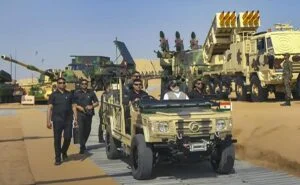
Why in news?
- The Bharat Shakti Tri-Service Indigenous Equipment Exercise held in Pokhran, Rajasthan, stands as a testament to India’s burgeoning defense capabilities and its steadfast commitment to self-reliance.
- Spearheaded by Prime Minister Narendra Modi, this exercise serves as a showcase of domestically developed weapons and systems, highlighting India’s strides towards autonomy in defense manufacturing.
- In this comprehensive blog, we will delve into the intricacies of the exercise, its objectives, and the strategic significance of Pokhran as its chosen venue.
Bharat Shakti Exercise Overview:
- Set amidst the rugged terrain of Pokhran, Rajasthan, the Bharat Shakti exercise is a grand display of India’s indigenous defense prowess.
- The exercise accentuates the effectiveness of network-centric systems and secure communication technologies while emphasizing seamless integration across the Army, Navy, and Air Force.
- With a focus on military hardware such as Pinaka rocket launchers, K-9 artillery guns, drones, and Tejas fighter aircraft, Bharat Shakti serves as a beacon of India’s self-sufficiency in defense production.
Objectives of Bharat Shakti
- At the heart of Bharat Shakti lies the objective of showcasing India’s self-reliance in defense capabilities.
- By spotlighting domestically developed weapons platforms and systems, the exercise evaluates the efficacy of indigenous technologies and fosters greater synergy among the armed forces.
- Moreover, Bharat Shakti aligns seamlessly with the national policy of “Atma Nirbhar Bharat,” aimed at reducing dependence on foreign military hardware and technology, thereby fortifying India’s strategic autonomy.
Pokhran: A Strategic Venue
- Nestled amidst the arid expanse of the Thar Desert, Pokhran holds a storied past in India’s defense history.
- It gained global attention as the site of India’s first nuclear test in 1974, famously known as Operation Smiling Buddha or Pokhran I.
- Despite initial international skepticism, India’s bold move under the leadership of Prime Minister Indira Gandhi established its position as a nuclear power. Today, Pokhran continues to play a pivotal role in India’s defense strategy, hosting exercises like Bharat Shakti to underscore the nation’s indigenous defense capabilities.
Conclusion
- The Bharat Shakti Tri-Service Indigenous Equipment Exercise encapsulates India’s unwavering resolve to achieve self-reliance and indigenization in defense manufacturing.
- Conducted in Pokhran, Rajasthan, the exercise serves as a potent symbol of India’s journey towards autonomy in defense production. As the nation embarks on the path of “Atma Nirbhar Bharat,” exercises like Bharat Shakti emerge as crucial milestones, reaffirming India’s commitment to safeguarding its sovereignty and securing its interests through indigenous innovation and self-sufficiency in defense.
People also ask
Q1: What is the Bharat Shakti Tri-Service Indigenous Equipment Exercise?
Ans: This exercise is a war game conducted in Pokhran, Rajasthan, showcasing India’s indigenous defense capabilities. It involves the integration of the Army, Navy, and Air Force, focusing on domestically developed weapons and systems.
Q2: What is the significance of Pokhran as the venue for the exercise?
Ans: Pokhran holds historical significance as the site of India’s first nuclear test in 1974. It symbolizes India’s strategic resolve and serves as a fitting backdrop for showcasing indigenous defense capabilities in a remote and controlled environment.
Q3: What are the primary objectives of the exercise?
Ans: The main objective is to portray and assess India’s self-dependence in defense capabilities. It aims to showcase the effectiveness of domestically developed weapons platforms and systems while fostering greater synergy among the three wings of the Indian Armed Forces.
Q4: How does the exercise contribute to India’s broader defense strategy?
Ans: It aligns with India’s national policy of “Atma Nirbhar Bharat” (Self-Reliant India), which seeks to reduce dependence on foreign military hardware and technology. By highlighting indigenous defense capabilities, the exercise strengthens India’s defense posture and enhances strategic autonomy.
Q5: What are some of the key highlights of the exercise?
Ans: The exercise features a wide array of military hardware, including Pinaka rocket launchers, K-9 artillery guns, drones, and Tejas fighter aircraft. It also emphasizes the use of network-centric systems and secure communication technologies to demonstrate the robustness of indigenous defense systems.
Thanks for sharing. I read many of your blog posts, cool, your blog is very good.